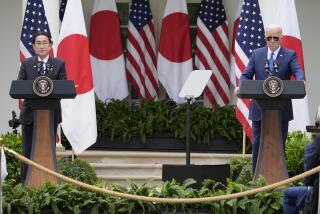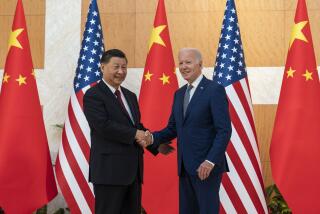ROUND 3 : For Japan and U.S., the choice is to fight or cooperate
- Share via
WASHINGTON — When President George Bush was preparing, in August, for his visit to Japan, the State Depart ment’s “talking points” for his meeting with the Japanese prime minister stressed the importance of the “U.S.-Japan partnership” in confronting the great issues of the time, starting with the breakup of the Soviet Union. U.S.-Japan economic tensions were dismissed as minor irritants, unimportant compared with the two countries’ global responsibilities. Indeed, the President was prepared to state that U.S.-Japan relations should not be “monopolized” by mere commercial disputes.
Then came the surprise defeat of the President’s candidate in the U.S. Senate race in Pennsylvania and Bush’s abrupt postponement of the Pacific tour. But as soon as planning began for the rescheduled visit, set to begin Monday, it became obvious that it would be difficult to structure the President’s attitude toward Japan. If he did what the diplomats desired--speak on the new “partnership” and geopolitical issues--the visit would be a political disaster at home. If he heeded his political advisers--loudly demand that the Japanese adopt market-opening measures--the visit would be a diplomatic disaster.
A brilliant tactical solution was found. The President would take Lee Iacocca and some 19 other business leaders with him, leaving it to them to do the shouting, while Bush could act “presidentially” by concentrating on his favorite geopolitical questions. Of course, some of these businessmen already have comfortable arrangements in Japan, but that would not matter. The media of both countries could be counted on to give greater prominence to Iacocca’s vivid expression of American complaints against Japanese economic practices. Thus, the media coverage would present a new President, one properly focused on the trade imbalance and the resulting unemployment it causes in the United States. Already, Bush has said that his Pacific tour will be a “search for jobs.”
Unfortunately, there is no such brilliant solution to the underlying problem of U.S.-Japan relations. Rather, fundamental strategic change is required. The economic tensions that began in the 1960s, mainly over Japanese textile exports, are now much deeper and broader than ever before, despite 30 years of diplomacy.
When the United States was preoccupied with its great struggle against communism and the Soviet Union, and Japan was considered an increasingly valuable ally, all economic disputes between the two countries were regarded as basically unimportant by both U.S. officials and public opinion. True, Japan exported more and more, while importing few U.S. goods, and those reluctantly. True, Japanese banks and investors expected to operate freely in the United States, while Japanese bureaucrats schemed to handicap or keep out foreign banks and foreign investors. Still, all this counted for much less than the role of Japan as a base for U.S. military power against the Soviet Union.
Thus was the “friction” stage in U.S.-Japan relations, which lasted until the late 1980s. The word friction is significant. An engineering term, it describes the minor surface interference that can occur even in a well-designed mechanism. Usually, it is enough to apply some oil to solve the problem. The implication was that U.S.-Japan economic relations were fundamentally sound. A few trade-union leaders and businessmen disagreed, but their complaints were ignored by the State Department. When they appealed to Congress and the White House, they sometimes received help, but mostly they were sent off with the message that they should work harder and compete more effectively.
A great deal of “oil” was poured on U.S.-Japan relations. American presidents and Japanese prime ministers regularly met to proclaim that relations between Washington and Tokyo were excellent, that progress toward liberalizing the Japanese economy had been achieved and that more liberalization was in the offing. Thus was established a pattern of deception--on both sides.
In Washington, it was increasingly understood that Japanese economic policy is largely controlled by the Ministry of International Trade and Industry and, even more so, by Ministry of Finance bureaucrats, along with their big-business colleagues. Nevertheless, U.S. presidents acted as if they were ignorant of this: They persisted in urging Japanese prime ministers to make promises they couldn’t begin to keep. The Japanese prime ministers, for their part, lacked the courage to admit that their powers were limited. The result was an accumulation of American resentments over broken promises. While the Cold War lasted, the consequent hostility was almost fully suppressed but not forgotten. The ill-feeling account kept building up, and the bill is now being presented in full.
But the “friction” theory of U.S.-Japan relations was collapsing even before the end of the Cold War. The failure of the huge devaluation of the dollar, in 1985, to close the trade gap with Japan, or even narrow it significantly, showed that the problem was not just frictional. The cheaper dollar virtually eliminated the U.S.-Europe trade gap. Not so with the Japanese. The “machine” was simply not working.
Enter a new theory of U.S.-Japan relations: There were “structural impediments” blocking the proper workings of supply and demand. Applying diplomatic oil wasn’t enough. The offending “parts” would have to be cut out. That was the goal of the Structural Impediments Initiative talks--to persuade the Japanese to change a variety of regulations, bureaucratic habits and business customs, while ceasing to protect rice farmers and small shopkeepers.
In other words, to solve the trade imbalance caused by the relentless export drive of a handful of corporations, Japanese society would have to be transformed in ways that would disrupt the way of life of many millions of ordinary Japanese. If Japanese politics were more democratic than they are, the entire concept would have been rejected at birth. As it was, however, the structural-impediment talks have the powerful support of big business and its bureaucratic allies. They can now blame “American pressure” to overcome legal and customary restrictions that they wanted to abolish anyway. Ironically, while the damage to people-to-people relations was certain, most experts agreed that the negotiations would not lead to much improvement in the two countries’ trade balance. Yet diplomats on both sides pressed on, because they did not want to admit failure.
This stage in U.S.-Japan relations might have lasted longer but for the August coup against Mikhail S. Gorbachev’s government. Had Gorbachev’s policy of slow change under Communist Party control continued to hold center stage, the Soviet threat that unified the United States and Japan would also have remained, even though weakening. Thus, the inevitably slow progress of the structural-impediment talks might have been sufficient to keep U.S.-Japan tensions under control.
But the August coup and the demise of the Soviet threat have removed the barriers to U.S.-Japan hostility. They have also left American society without an enemy.
U.S. society has two basic political modes: internal divisions spawned by ideas--from slavery and Prohibition, to abortion and affirmative action--or a wonderful unity against an external enemy. The Soviet Union was an excellent Chief Enemy for more than 40 years; Saddam Hussein could only keep the job for five months. If Americans were an imperial people, they would keep celebrating their small victory over Iraq and their great one over the former Soviet Union. But Americans are not like the British, who still gloat over the Falklands success. The sudden emergence of the United States as the greatest global power in human history leaves them indifferent.
Instead, Americans are concentrating on their country’s long-term economic decline, which they have largely ignored. As Bush has just discovered, American political life is undergoing one of its classic transformations, with everybody’s priority being economic reconstruction. That task, however, requires a Chief Enemy to unify Americans and make the necessary sacrifices acceptable. And only Japan fits that role. Anybody who follows the U.S. media closely can see that a new Chief Enemy is being constructed, headline by headline.
True, Japan has no rival ideology. But as an economic enemy, Japan is perfect, and 30 years of shortsighted tactics on the part of both sides have made it so. The time for clever diplomatic maneuvers is past; any attempts to deal with the problem by more lobbying and more talk will only make matters worse. For American society will accept all sacrifices, and it will reconstruct the U.S. economy.
If Americans cannot do so with Japanese cooperation--beginning with immediate export restraint, followed by rapid market-opening measures--they will reconstruct by unifying against Japan. Everybody knows that Japan’s political leadership is simply too weak to carry out any policy quickly. But perhaps the same few Japanese corporations that have caused the problem will see the wisdom of solving it by themselves. For we are now at the third stage of U.S.-Japan relations: A choice between conflict and cooperation can no longer be avoided.
More to Read
Get the L.A. Times Politics newsletter
Deeply reported insights into legislation, politics and policy from Sacramento, Washington and beyond. In your inbox twice per week.
You may occasionally receive promotional content from the Los Angeles Times.










